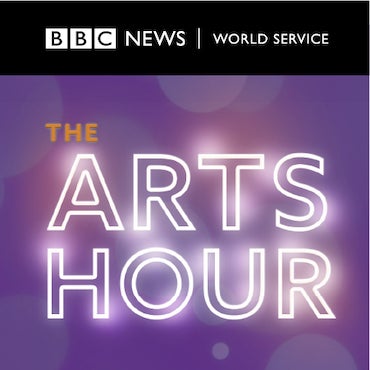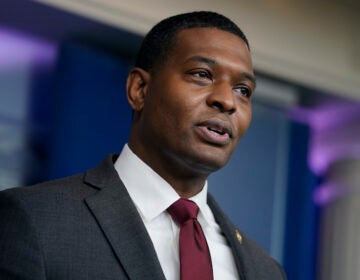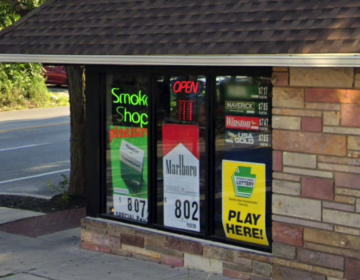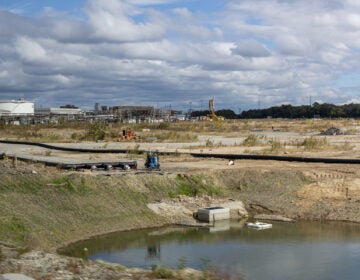Principles built around safety
Feb. 13
By Linda K. Harris
For PlanPhilly
On Monday night at St Peter’s School on Lombard Street in Society Hill, Penn Praxis began conducting a second round of public discussions centered on creating principles that would guide experts who will create a design for the development of the seven miles along the Central Delaware River waterfront.
The process involved a series of interviews between attendees. “It’s an odd process, but it works, it’s fascinating,” said Lisa Santer, one of the group facilitators. “It gets us a lot of information in a short amount of time.”
After an introduction from Penn Praxis director Harris Steinberg, the crowd was divided into five groups. In a nearby classroom, one group of 10 people lined up on either side of diminutive desks and child-size chairs to begin the process.
Jose Morales and Sally McAfee moderated along with Santer. The themes focused on “a safe place to live,” “varieties of diversity and culture,” “economic sustainability,” “the environment” and “history.”
At one end of the line of tables, Rinda Schwartz of Society Hill was questioning George Saulino of South Philadelphia about the value of diversity and culture.
“Since I was born and raised in this area,” Saulino said, “I always felt we lived in a melting-pot neighborhood. I always thought that’s how we learn from each other.”
“How would you perpetuate this?” Schwartz questioned, moving the conversation to the principles phase.
Saulino suggested some kind of facility or designated space where families could go and research their history in this country. “Ellis Island,” he suggested, “build something like that.”
The process then called for Saulino to question Schwartz about his designated question, which was one of safety.
Schwartz and, as it turned out, others in the group, related safety to having lots of people around.
“The more appealing a place is, the safer it’s going to be,” she said.
Martha Swartz of Washington Square West then shifted into Rinda Schwartz’s chair, as the process called for.
Swartz’s question pertained to economic development and sustainability.
The pair discussed creating an educational program for children and students around the ships and the shipping industry. Martha Swartz suggested an historic tourist site similar to Plimoth
Plantation’s Pilgrim Village and Native American Homesite in Plymouth, Mass.
And then, as Morales had a timer clipped to his notepad, he called for the pairs to switch to the other partner’s question, which, in this case, was Saulino’s on safety.
Swartz answered that good lighting was important for safety, as was good landscaping “so as not to create havens for bad people to hang out.” And she thought nighttime events that attracted lots of people would increase security, too.
And so, with this process, in less than an hour, ideas bubbled up, were expressed and distilled.
Stephen Goldner of Society Hill said housing, hotels and construction promoted the economy. “There has to be a program to encourage development. The planners should locate the appropriate places for housing.” Goldner also would like to see more riverfront walkways. “I walk my dog there. I enjoy it immensely, and I’d like to see it extended,” he said.
After the five questions were discussed and documented, the groups were reorganized so that each person’s question dictated to which group he or she was assigned.
For example, in one room, all the people who had made the inquiries regarding safety gathered to discuss the main themes that had emerged in their separate groups. This group was divided into three groups, their ideas distilled and then they reformed to put together a final draft of their ideas regarding safety. They were:
1) Safety in numbers
2) Enhanced access brings more people
3) Cover Interstate 95 and extend the city to the waterfront
4) Create more points of access and escape for pedestrians as well as boats
5) Make the riverfront a destination
See attached document for full report
Elizabeth Sauer of Chestnut Hill suggested that the sport of fishing be developed on the river as one way of encouraging families and others to use the river. She also thought restaurants and museums would attract people to the waterfront.
Eddie Battle of West Oak Lane said that attracting a diverse crowd can make people feel more safe. “With a mixture of people, there’s a synergy… many eyes, different ways of seeing things.”
Bryan McHale of Fox Chase said the neighborhood tradition of businesses on the first floor and residences above promoted safety by having a 24-hour presence of people. McHale also said that good design added to the safety factor. “Well designed places inspire people to behave better; the more chaotic, the more chaotic are people’s responses to it.”
Some people liked the idea of having a riverfront district with uniformed people on the scene who were not police but added to the feeling of safety, such as the Center City District’s representatives who help keep the streets clean and offer aid and advice to pedestrians and tourists.
Laura Spina of Center City suggested adding “strong animated corridors” to the river and adding signage, art and landscaping.
And Ross Brightwell of Maple Glen presented his idea of covering over Interstate 95 and turning the area into a Central Park-type presence, a “front-lawn” for the city.
And finally, the group decided that there should be a serious effort to develop pride around the waterfront.
After the discussions ended, Matt Wanamaker of Old City said he believed the evening’s sessions were useful.
“I’m glad that people are participating and that there are a number of people and different ideas. The method brought up new and fresh ideas, and we were able to put them into simple, almost sound bites.”
Linda K. Harris is a former writer and editor for The Philadelphia Inquirer. She lives and writes from South Philadelphia.
WHYY is your source for fact-based, in-depth journalism and information. As a nonprofit organization, we rely on financial support from readers like you. Please give today.






